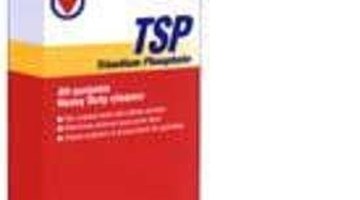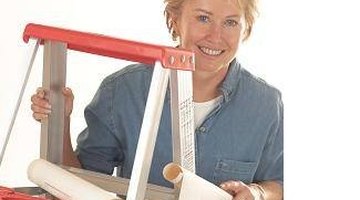Removing Wallpaper Paste With TSP
Trisodium phosphate (TSP) is a highly water-soluble salt that has been used for many years by painters to clean walls before painting. TSP's alkaline qualities make it an effective cleaner, able to remove most materials, including mineral spirits. Unlike many household soaps and detergents, it can be safely combined with bleach to clean and kill mold and mildew on surfaces. Since mildew often grows beneath wallpaper, TSP would appear to be a perfect solution for the job of removing wallpaper paste but, as anyone who's ever used it knows, its caustic nature makes certain precautions and preparations necessary. Eye protection, long sleeves and rubber gloves are imperative when using TSP and it should only be used in a well-ventilated area. Accidental ingestion or inhalation should require immediate medical attention. Contact with acids will create phosphoric acid, a deadly poison, so never eat or drink while using TSP or use it near acid-based cleaners like muriatic acid.
The Pro's Solution


The Decision to Use TSP

While modern wallpaper generally has adhesive that is easy to peel, applying even this paper over walls that have not been sized or pre-existing paper may present challenges when redecorating. Before resorting to strong chemicals like TSP, it's wise to try a few old-fashioned techniques first. Wallpaper steamers, available at rental outlets can help peel liner papers and paper remnants --- they can also shorten the job of removing old-style papers considerably. Once the paper has been removed, loose adhesive and remnants should be removed with a rough scrubber like the permanent plastic sandpaper blocks sold at paint supply stores or a plasterer's knife. The goal is to remove as much of the adhesive (which flakes easily when dry) off the wall before adding water and creating a gooey mess. If there's still a layer of adhesive, you may want to try cleaning with TSP.
Use and Precautions

Because TSP is so caustic, other detergents like TSP-PF (phosphate-free version of TSP) and other wall cleaners should be tried before resorting to TSP. Once the decision is made, however, wood and cloth surfaces should be masked with waterproof drop cloths to avoid spotting (TSP can dissolve varnish, too). Mixing directions on the label must be followed exactly and bleach should be added (again as the label directs) to kill any mildew. Surfaces should be cleaned from the bottom up to avoid allowing drips to sit in the surface. Scrub surfaces using a soft brush or cellulose sponge to loosen paste and follow from below with a soft cloth and clear water to catch drips before they can do any harm; never clean over eye level as the solution could fall onto the skin or into the eyes. When finished, the wall should be completely rinsed again with clear water to remove any residue. Anyone who uses TSP should wash hands and face before eating or continuing with decorating tasks.
Resources
Writer Bio
An avid perennial gardener and old house owner, Laura Reynolds has had careers in teaching and juvenile justice. A retired municipal judgem Reynolds holds a degree in communications from Northern Illinois University. Her six children and stepchildren served as subjects of editorials during her tenure as a local newspaper editor.
Photo Credits
- Microsoft Office clip art, Savogran
More Articles



